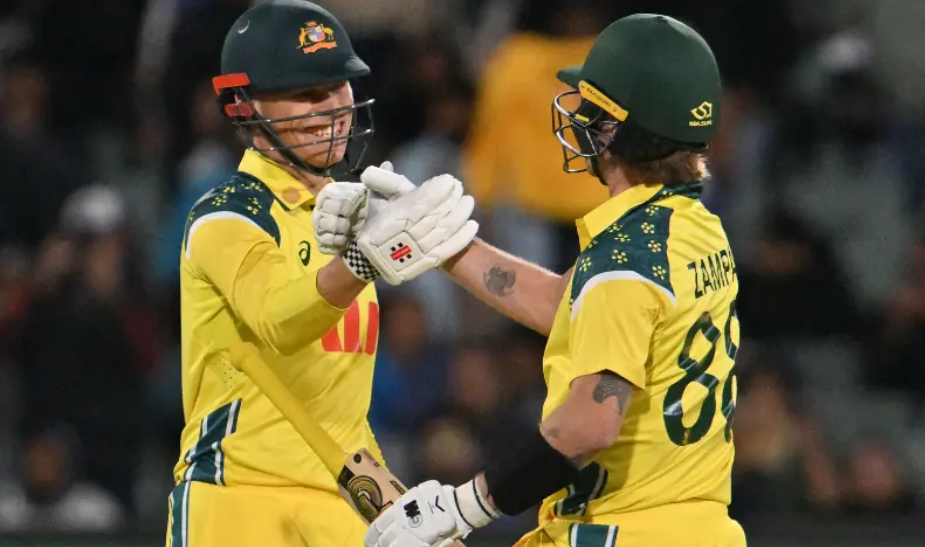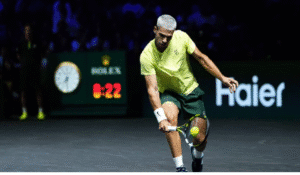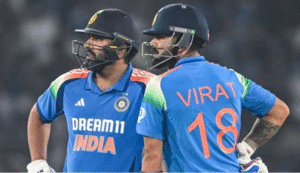Short and Connolly Shine as Australia Beat India to Seal ODI Series

Meta Description:
Matt Short’s composed 74 and Cooper Connolly’s maiden half-century guided Australia to a thrilling two-wicket win over India in Adelaide, clinching the three-match ODI series with one game remaining.
Introduction: Australia Continue Their Dominance Over India
Australia have once again proved why they remain one of the most resilient teams in world cricket. In a tightly contested match at a sold-out Adelaide Oval, Matt Short and Cooper Connolly led from the front as Australia edged past India by two wickets to clinch the three-match ODI series 2–0 with one game still to play.
It was a contest that swung both ways — India posting a competitive 264-9 on the back of skipper Rohit Sharma’s 73 and Shreyas Iyer’s 61, before Australia chased it down with 22 balls to spare. The heroes of the day were Matt Short, who made a gritty 74 under pressure, and young Cooper Connolly, who showcased remarkable composure to finish unbeaten on 61.
The victory followed Australia’s seven-wicket win in a rain-affected opening ODI in Perth, giving the home side another series win over a full-strength Indian lineup — and continuing their winning momentum under captain Mitch Marsh.
Early Setback, Steady Recovery
Tentative Start in the Chase
Chasing 265 on a slightly tacky Adelaide pitch, Australia made a nervous start. Captain Mitch Marsh looked to set the tone early but was undone by Arshdeep Singh for just 11, slicing a mistimed pull shot straight to point.
Shortly after, Travis Head (28) fell cheaply, thick-edging debutant Harshit Rana to Virat Kohli at slip. At 41 for 2 inside the first 10 overs, the crowd’s excitement gave way to quiet tension.
Short and Renshaw Build the Foundation
The rebuild came courtesy of Matt Short and Matt Renshaw. Their partnership was the turning point of the innings — pragmatic, well-paced, and rich in intent. The duo added 55 runs for the third wicket, relying on quick singles and calculated aggression.
Renshaw’s 30 anchored the innings until he fell to Axar Patel, who deceived him with a quicker delivery that darted through the gate.
From there, the middle order wobbled again. Alex Carey (9) attempted a premeditated sweep off Washington Sundar and paid the price. But while wickets fell around him, Short remained Australia’s backbone — calm, composed, and technically solid.
Short’s Composed 74: The Anchor That Held the Chase
A Mature Innings Under Pressure
Matt Short’s innings of 74 off 88 balls was the definition of composure. The 28-year-old, who has often been touted as one of Australia’s next-generation white-ball stars, finally translated potential into performance.
He was dropped twice — once on 43 and again on 65 — but didn’t let fortune go to waste. Short’s driving through cover was exquisite, and his use of the crease against India’s spinners showed maturity. He rotated the strike efficiently and kept the required run rate within reach.
It was a display of controlled aggression. When boundaries were needed, Short found them with minimum risk — especially against Sundar and Patel, whom he neutralized through smart placement rather than brute force.
His dismissal — caught at deep mid-wicket off Harshit Rana — came just when he looked set to finish the job. Yet, by then, he had done enough to tilt the momentum firmly in Australia’s favor.
Connolly and Owen Finish the Job
Youth and Calmness Under Pressure
If Short built the foundation, Cooper Connolly finished the masterpiece. The young left-hander, only a few matches into his international career, played with the calmness of a veteran. His 61 not out from 72 deliveries wasn’t just a half-century — it was a statement of intent.
Partnering with all-rounder Mitch Owen (36), Connolly rebuilt after Short’s departure. The pair added 68 runs for the seventh wicket, combining power and precision.
Owen’s cameo — featuring two fours and three sixes — broke the back of India’s resistance. His fearless striking against Axar Patel in the 41st over turned the equation from tense to manageable.
When Owen fell, Australia still needed 50 from the last 10 overs. Connolly, unflustered, steered the chase home with smart singles and occasional boundaries.
By the time he drove Arshdeep Singh through mid-off for the winning runs, Connolly had earned more than applause — he’d announced himself as a serious white-ball prospect for Australia’s future.
India’s Batting: Promise Without Punch
A Strong Start, a Familiar Collapse
Earlier in the day, India had a platform for a much bigger total. Sent in to bat after losing the toss, the visitors slipped to 17-2 early after an inspired opening spell from Josh Hazlewood and Xavier Bartlett.
Bartlett, playing in place of Nathan Ellis, struck twice in quick succession — first removing Shubman Gill (8) with a misjudged lofted shot, and then trapping Virat Kohli lbw for a four-ball duck.
It was a rare sight: Kohli dismissed for consecutive ducks in ODIs for the first time in his illustrious career.
At that point, India’s innings needed a savior — and Rohit Sharma answered.
Rohit and Iyer Rebuild the Innings
Rohit’s 73 off 84 balls was a captain’s knock. Under pressure, he played with intent, mixing aggression with restraint. Alongside Shreyas Iyer (61), he added 118 runs for the third wicket, stabilizing the innings.
Their partnership featured classic ODI cricket — quick running between the wickets, well-timed boundaries, and minimal risks. For nearly 20 overs, India looked in control.
But as so often happens in Australia, momentum shifted once the ball aged and movement returned.
The Collapse
Mitchell Starc returned for a fiery second spell, dismissing Rohit with a short delivery that he mistimed to deep mid-wicket. Three overs later, Iyer followed — caught at slip off Adam Zampa.
The middle order faltered. KL Rahul (11), Axar Patel (44), and Nitish Kumar Reddy (8) all perished trying to accelerate. From 165 for 2, India stumbled to 264 for 9 — a collapse of seven wickets for 99 runs.
Axar’s late flourish saved India from complete embarrassment, but their inability to finish strong proved costly.
Australia’s Bowling: Discipline and Intent
Hazlewood and Bartlett Set the Tone
Josh Hazlewood was brilliant, especially in the powerplay. His first 13 deliveries were all dot balls — a spell of sustained accuracy that built immense pressure. Though wicketless early, he forced errors that Bartlett capitalized on.
Bartlett’s inclusion proved inspired. His 2 for 38 disrupted India’s top order, including the priceless scalp of Kohli. His consistency and ability to extract bounce off the pitch suggest Australia have unearthed another reliable ODI seamer.
Zampa’s Spin Web
Adam Zampa once again proved his worth in middle overs. The leg-spinner returned with figures of 4 for 43, including key wickets of Iyer, Rahul, Patel, and Reddy.
Zampa’s ability to vary pace and flight on a surface that offered only moderate turn was instrumental. Every time India looked to build momentum, Zampa struck — stifling their scoring rate and forcing risky shots.
Starc’s Impact
Mitchell Starc’s fiery bursts reminded everyone why he’s one of the best ODI bowlers of his generation. His short-pitched delivery that removed Rohit was vintage Starc — pace, accuracy, and aggression rolled into one.
He finished with figures of 1 for 46, but his control and hostility were worth much more.
What Went Wrong for India
Fielding and Missed Chances
India’s bowlers had moments but were let down by sloppy fielding. Two crucial dropped catches off Matt Short — one by Shreyas Iyer and another by KL Rahul — proved decisive.
Captain Shubman Gill admitted as much afterward:
“I think we had just enough runs on the board. But when you drop a couple of catches, defending those totals becomes very difficult.”
Lack of Penetration
Beyond the new ball, India’s attack looked toothless. Arshdeep Singh and Harshit Rana lacked consistency in line and length, while the spinners — Patel and Sundar — struggled for breakthroughs in the middle overs.
The absence of Jasprit Bumrah, resting after a long Test series, was clearly felt. Without him, India’s bowling lacked the x-factor to sustain pressure across 50 overs.
Series Context and Takeaways
Australia’s Balance and Depth
Australia’s strength once again lay in their balance. Even after losing top-order wickets early, they had batting depth all the way down to No. 8. Players like Connolly and Owen stepping up under pressure reflect a system that continuously produces clutch performers.
India’s Middle-Order Concerns
India’s middle order remains inconsistent. Outside of Rohit and Iyer, no batter has consistently anchored innings under pressure. With the ODI World Cup cycle approaching, this inconsistency could become a major concern for selectors.
Bowling Mastery
For Australia, the form of Hazlewood and Zampa offers immense encouragement. Together, they’ve now accounted for more than half of India’s wickets in this series. Their control, patience, and tactical nous make them lethal in any conditions.
What’s Next
The series now heads to Sydney for the final ODI — a dead rubber in terms of results, but still significant for both sides.
For Australia, it’s a chance to experiment with combinations, perhaps giving more game time to emerging players like Bartlett and Connolly. For India, it’s an opportunity to salvage pride and avoid a clean sweep.
Marsh made it clear that Australia will not be taking the foot off the pedal:
“It’s awesome and rapt to have won the series. The bowling unit was unbelievable and the batting was clinical. We’ll certainly enjoy this win, but we’re going to Sydney looking for 3–0.”
Conclusion
Australia’s two-wicket win in Adelaide wasn’t just about sealing another series; it was about resilience, adaptability, and the emergence of new heroes.
Matt Short’s 74 anchored the innings, Cooper Connolly’s unbeaten 61 sealed it, and Zampa’s 4-for ensured the target remained within reach. It was a complete team performance built on unity and execution.
India, meanwhile, showed flashes of brilliance but were undone by lapses in concentration — dropped catches, a sluggish middle phase, and missed opportunities.
As both teams look ahead to the final ODI in Sydney, the message is clear: Australia’s depth remains unmatched, while India must find answers before the next big series looms.






